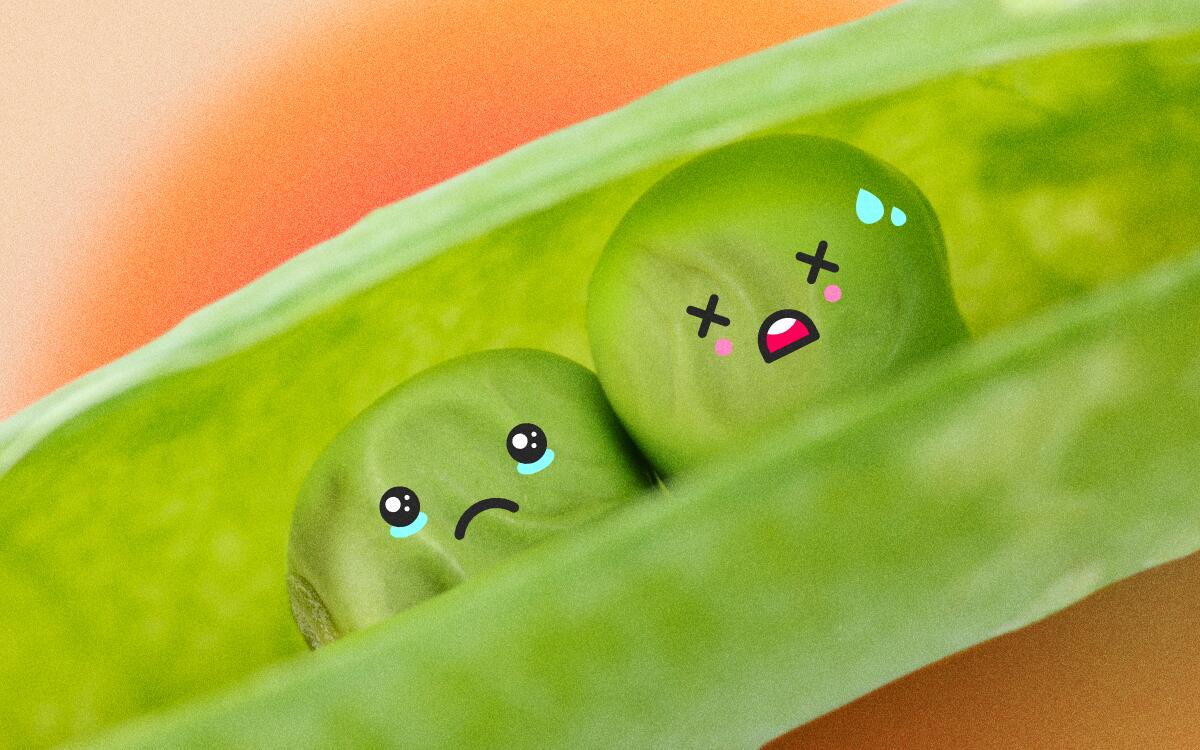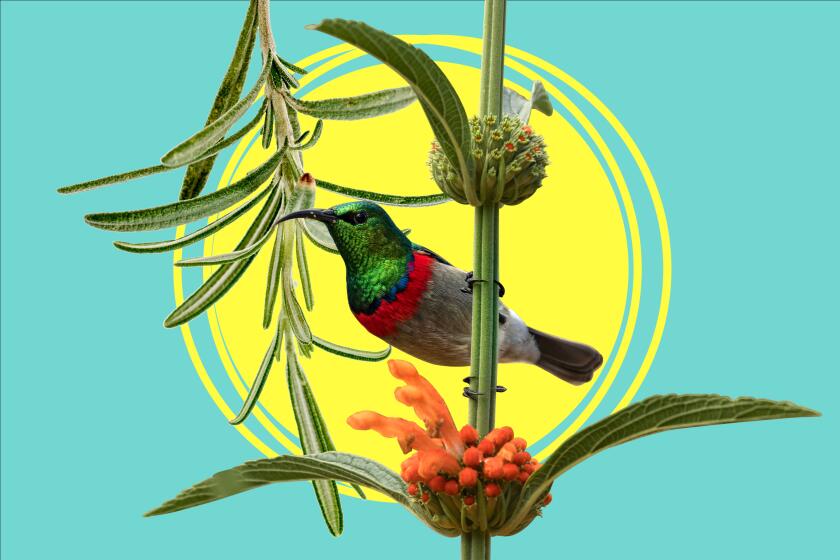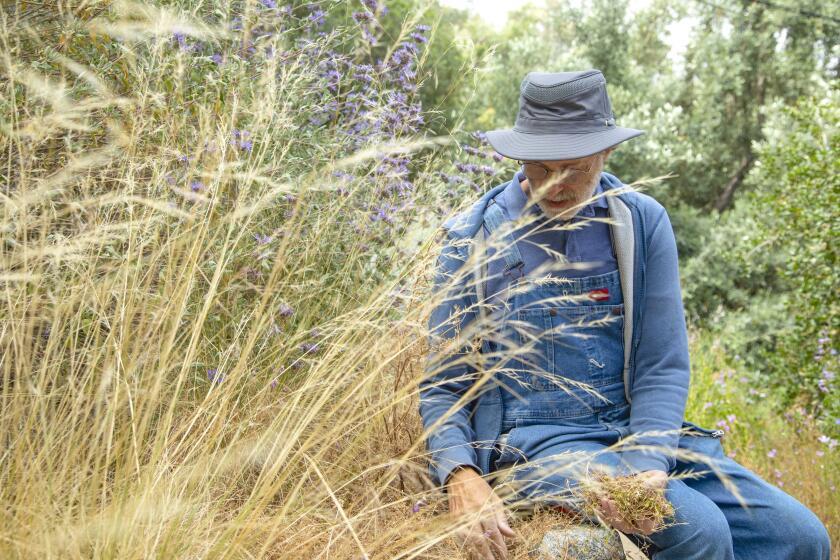We’re in a heat wave. That’s going to completely change your winter garden plans

- Share via
When Yvonne Savio talks, savvy SoCal gardeners listen. And her message for fall is big: Despite a long tradition of planting during the “mild” days of September, her counsel this week is to put off any planting — even starting seeds — until late October or November, because folks, it’s just too darn hot these days, especially with the drought-induced restrictions on outdoor watering.
“We may or may not have enough water to keep them sufficiently watered to thrive. I’m talking thrive, not survive,” said Savio about cool-season plants, such as leafy greens, arugula, broccoli and peas. “It’s basically a waste for you to start seeds this month or next month, since you can’t put them outside, so I’m giving you a good excuse to put it off until November.”
This is especially true for communities where outdoor watering is banned from Sept. 6 to 20, to allow the Metropolitan Water District to do emergency repairs on the 36-mile Upper Feeder pipeline which delivers water from the Colorado River to Southern California.
Even in the best of conditions, transplanting is a shock to any plant’s system, and that stress is much worse when it happens in high heat, even with plenty of water — and nobody in SoCal has plenty of water these days.
Southern California is dealing with dangerous triple-digit temperatures. Here are tips for keeping your plants alive when the weather is sweltering.
Savio has been gardening at her Pasadena home for some 60 years — starting as a child when her parents first began growing there — and she made gardening her career, including 25 years as director of Los Angeles County’s master gardener program. Her website and blog, Gardening in LA, is full of useful advice for every month of the year. Her original description of September gives you an idea of how much our climate seems to be changing: “September’s mildness makes just about any gardening tasks pleasant. The soil and air are warm but not overly hot. Fresh summer produce is still delicious, but production is slowing down. .... Seeds and transplants of cool-weather-hardy crops can be planted now for harvests from fall through early spring. ...”
Those were the days, when we had temperate “shoulder seasons” in June and September, a transition time between spring and summer, summer and fall, that was not too hot and not too cold. But SoCal gardeners can’t really count on those mellow seasons anymore, Savio said.
“This is why three years ago I stopped putting in my second big crop of tomatoes in June,” she said. “It was getting so hot, my transplants could not get sufficiently established in order to give me a decent crop, even with me pouring water on them.”
Ordinarily, Savio said, she’d be telling people, “‘This is a good time to plant fall color shrubs and trees too, when the soil is nice and warm,’ but for the next month or two I’m saying, ‘Don’t plant anything new. Just take care of the stuff you have.’”
And there are plenty of garden things to do while we wait for rain (fingers crossed) and cooler temperatures, Savio said. Here is her advice:
- Deep water your trees. First and foremost, focus whatever water you have — even if you’re collecting it from the shower or the sink — on keeping your trees. Ideally, mature trees should get a slow deep watering a couple times a month, saturating the soil a good 12 inches down, and young trees should get a good drink at least once a week until they’re established. Our region is going to need all the shade we can get with our rising temperatures.
- Pull out those dying veggie plants. By the end of August, many SoCal vegetable gardens are looking pretty ragged, if they survived at all after weeks of high heat and limited water. If your garden is looking “mostly dead,” don’t harbor the hope that it will miraculously rebound after the coming heat wave. (Even Miracle Max from “Princess Bride” can’t pull that off.) Pull out those withered plants so you can start preparing your winter garden.
- Use this hiatus to nourish and rebuild your soil. Summer veggies are heavy feeders, so your garden soil is likely depleted of the nutrients all plants need to thrive, especially if you’ve been growing in a container. Once you remove your spent plants, refresh or replace your garden space with fresh soil (in the case of containers) and amendments such as compost, steer manure and worm castings.
- Avoid heavy pruning on roses and shrubs until it gets cooler. Your plants may look sun-blistered, but cutting off all those leaves is another shock to their system at a time when they’re trying to survive scorching temperatures. In addition, Savio said, those brown leaves and branches serve as protection against additional damage and could be harboring living tissue, so wait a few months before you start any major pruning.
- A few trims are OK if you want to create new plants through propagation. This is best done on leggy plants, healthy ones with longish branches. Take cuttings, put them into damp soil and wait for them to root into new plants (potential gifts for family and friends). Savio has instructions for propagating begonias on her website, which she says will work on most plants. She recommends making your cuts somewhere between the hard wood of a branch, which won’t easily root, and the soft pliable tip, which won’t have enough structure to root.
- Trims are also OK for harvesting fresh herbs to dry. Some people put their herbs in a paper bag with a couple of holes near the top for ventilation and hang it outside on hot days to dry herbs like marjoram, thyme, rosemary and basil for storage. Savio explains her method for drying herbs in the oven on her website.
- Wait to plant cool-season veggies in November. By then, we might even have a chance for some rain, but the temperatures should be mild enough to put tender seedlings in the ground and have them survive. Cool season crops include beets, carrots, broccoli, Brussels sprouts, peas, onions, garlic, potatoes and leafy greens like lettuce, spinach and arugula. Cabbage and cauliflower are cool-season crops too, but they take up a lot of room and only produce one crop per plant, so unless you have a huge garden space, consider brassicas like broccoli and kale, which produce multiple crops.
- If you want to start cool-season crops by seed, at least wait until October, because, again, the seedlings won’t do well when the temperatures are hot and they will get too leggy if you start them in September and can’t plant them until November.
Drought-resistant plants like hummingbird sage and rosemary are the ideal addition to Southern California gardens.
Lastly, use this time to get educated about native plants and lawn removal or check out these other plant-related activities in September. Email events to [email protected] at least three weeks before they happen, and we might include them in the calendar.
Through Oct. 20
CalRecycle’s Community Composting for Green Spaces Grant Program is accepting applications now through Oct. 20 for competitive grants to create, improve or expand community composting sites in the Inland Empire (including Riverside and San Bernardino counties), greater Los Angeles area (including Los Angeles, Orange, Santa Barbara and Ventura counties) and the San Diego and Imperial area (including San Diego and Imperial counties) as well as northern counties in the state. calrecycle.ca.gov
Sept. 3
The Huntington Library, Art Museum, and Botanical Gardens presents the 39th Succulent Plants Symposium from 9 a.m. to 5 p.m. in Rothenberg Hall, 1151 Oxford Road in San Marino. Speakers include the Huntington’s John Trager as well as Root Gorelick of Carleton University, Guillermo Rivera of Plant Expeditions in Florida, Jared Margulies of the University of Alabama, Daniel Mahr of the University of Wisconsin, and Olwen Grace of the Royal Botanic Gardens in London. A continental breakfast and lunch are included with registration, which is required in advance. Tickets are $100. huntington.org
Sept. 7
Comprehensive Irrigation for California Native Plants, a workshop presented by Tim Becker, horticultural director of the Theodore Payne Foundation, from 9 a.m. to noon at 10459 Tuxford St. in Sun Valley. Tickets are $65 ($55 for members) eventbrite.com
Native plant gardens can look dead over the summer, but there are things you can do to tend to the dried-out vegetation.
Sept. 8, 15, 22 & 29
Introduction to Gardening, a workshop offered every Thursday for four weeks from 10:30 a.m. to 12:30 p.m. at Sherman Library & Gardens, 2647 East Coast Hwy. in Corona del Mar. The class is designed to help beginners learn how to grow flowers, plants and food even in small spaces and includes instruction in planting bulbs for winter blooms, caring for indoor plants, easy vegetable gardening and growing California native plants. Each class begins with a talk or tour of the gardens and ends with a plant or project to take home. The workshop is limited to 10 participants. The cost is $120, and online registration is required. thesherman.org
Sept. 9
Exploring Pasadena: The Original Busch Gardens, a presentation by historian and author Michael Logan about the forerunner of Southern California’s mega-gardens at the Pasadena Museum of History, 470 W. Walnut St., at 7 p.m. Logan’s new book on the subject will be available for purchase and signing. Admission is $15 ($10 for members). pasadenahistory.org
Sept. 15
Native Plant Maintenance, a walk and talk with Theodore Payne Foundation nursery staff member Erik Blank, 9 to 10 a.m. at the foundation’s demonstration gardens, 10459 Tuxford St. in Sun Valley. Participants should wear closed-toe shoes, long pants and be prepared to walk on sometimes steep and uneven surfaces for an hour. Water bottles and sunscreen are also encouraged. Tickets are $15 ($12 members). eventbrite.com
Sept. 17
Plants + Coffee, a Black Thumb sponsored event, is a meeting of people of color in Los Angeles’ plant world to network over a shared love of plants and do volunteer work at MudTown Farms from 8 to 10 a.m. at 2001 E. 103rd St. in Watts, in collaboration with the Watts Labor Community Action Committee, MudTown Farms, the Black Bean Coffee & Tea Company and Black Men With Gardens. The meeting is free but participants must RSVP online. blackthumbmarket.com
Sept. 17-18
Southern California Begonia Society Begonia Plant Show & Sale, 10:30 a.m. to 4 p.m. at Sherman Library & Gardens, 2647 East Coast Hwy. in Corona del Mar. The show includes various types of begonias, including canes, tuberous, rhizomatous and Rex. Mature examples will be displayed in pots, and terrariums and many will be available to buy. The show is free with $5 admission to the gardens. (Members and children 3 and under enter free.) thesherman.org
Sept. 18
How to Grow a Cocktail-Inspired Garden, 2 to 4 p.m. at South Coast Botanic Garden, 26300 Crenshaw Blvd., in in Rolling Hills Estates. Terry Huang, the garden’s director of living collections, explains how to grow and harvest your own herbal ingredients and turn them into seasonal infusions and syrups for cocktails and mocktails. The class is outdoors and guests will be treated to a seasonal cocktail happy hour. Tickets ($50 or $40 for members) include admission to the garden and two craft cocktails or mocktails. southcoastbotanicgarden.org
Finding your favorite nursery can be thrilling. Here are our picks for the best independently owned plant nurseries near Los Angeles.
Sept. 24
The Los Angeles County Arboretum’s Family Night Hike: Garden Sweets and Treats, a guided walk through the gardens to discover the origins of our favorite sweet treats, 5:30 to 7 p.m. at the, 301 N. Baldwin Ave. in Arcadia. $20 ($15 members). arboretum.org
Sept. 25
Urban Foraging Workshop fundraiser for Sustainable Claremont, 10 to 11:30 a.m. at Hahn Hall, 420 Harvard Ave. N. in Claremont. Leader Douglas Kent, a landscape architect and author of “Foraging Southern California,” says the walk will cover 1.5 miles “at a snail’s pace” in Claremont, and people of all ages are welcome. Proceeds support Sustainable Claremont, a nonprofit organization that promotes education, environmental and beautification programs in Claremont and neighboring cities. Tickets are $45. eventbrite.com
More to Read
Sign up for The Wild
We’ll help you find the best places to hike, bike and run, as well as the perfect silent spots for meditation and yoga.
You may occasionally receive promotional content from the Los Angeles Times.















